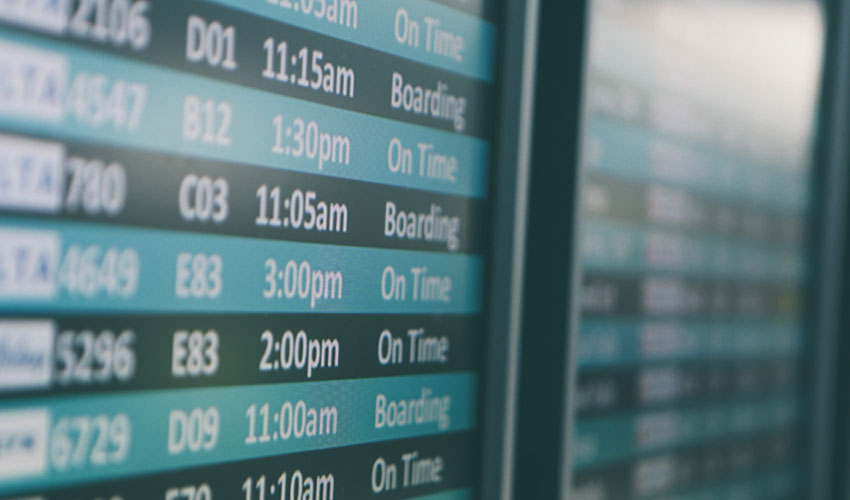There is a lot for the aviation industry to be optimistic about as we wrap up the first month of 2023. We are already seeing a pronounced return to pre-pandemic levels for global aviation activity. In addition, many airlines are experiencing improved on-time performance with some airlines leading the pack on punctuality. Finally, the industry continues to aggressively pursue its sustainability goals with enhanced focus and progress in the area of sustainable aviation fuels.
Projections Are for Global Aviation to Reach Pre-Pandemic Levels by June
Based on a recently published paper by the international aircraft leasing company, Avolon, global aviation traffic is expected to reach its pre-pandemic levels by June 2023. We have already witnessed a 70% recovery in 2022 in Europe and North America, while Asia will dominate the continued recovery with China’s reopening of air travel. The recovery so far has helped turn the tide on the industry’s losses in 2020 and 2021 with 2022 seeing the industry’s return to profitability. As for this year, 2023, profits of $4.7 billion are currently projected.
Avolon CEO Andy Cronin stated, “Aviation has demonstrated its resilience and is ready to thrive having come through a pandemic-driven two-thirds drop in traffic.”
Airlines still have to grapple with their capacity recovery which is lagging behind their financial recovery. Despite revenues being just 13% lower than 2019 levels, capacity remains 25% below what it was in 2019.
Aircraft delivery delays are troublesome with a significant shortage due to the lost production of planes previously planned, but not manufactured as a result of the pandemic. With rebounding air traffic, the new aircraft shortage is further intensifying supply tensions, thereby supporting long-term residual values. Since 2019, airlines have reduced their fleets by 3% while lessors have increased their fleets by 17%. Lessors now manage 53% of the global passenger fleet based on value. Higher interest rates and lease rates are creating new opportunities for well-capitalized investment grade lessors.
While sustainable aviation fuel (SAF) production tripled n 2022, at 1% of the goal set for 2030, t still has far to go.
Look Which Airlines Earning Bragging Rights as World’s Most Punctual in 2022
Congratulations to these airlines which demonstrated the best on-time performance record in 2022! Cirium’s performance rankings are noted for those airlines that placed among the “Top 10” on Cirium’s list of the best global airlines for on-time performance.
In Latin America:
- Azul Brazilian operated an estimated 280,000 flights in 2022 with 88.93% of its flights arriving within 15 minutes of their scheduled times. (#1)
- LATAM Airlines (Chile) achieved 86.31% punctuality across over 450,000 flights. (#4)
- Avianca (Columbia) attained an 83.48% punctuality across almost 145,000 flights. (#6)
In America:
- Delta earned Cirium’s Platinum Award for global operational excellence, with 83.63% punctuality for its 1,004,684 flights. (#5)
- United Airlines performed well with 80.46% punctuality for its 789,200 flights. (#8)
- American Airlines recorded punctuality for 78.29% of its 1,076,100 flights. (#10)
- Southwest, which had a serious meltdown with heavy cancellations during the peak holiday season, realized punctuality for 74.06% of its flights.


In Asia-Pacific:
- StarFlyer (Japan), named the world’s leading low-cost carrier, achieved 95.23% punctuality across almost 22,000 flights.
- Nippon (Japan) posted 88.61% punctuality for its 162,370 flights. (#2)
- Japan Airlines posted 88/00% punctuality for its 165,981 flights. (#3)
In the Middle East:
- Emirates achieved 81.30% punctuality for its 137, 589 flights (#7)
- Qatar Airways achieved 78.32 punctuality for its 152,377 flights. (#9)
No European airline made the Cirium list.
As for Cirium’s top-performing global airports, U.S. airports dominated. Haneda (Tokyo, Japan)) placed first, followed in order by Kempegowda International (Bangalore, India), Salt Lake City International (Utah), Detroit Metropolitan Wayne County (Michigan), Philadelphia International (Pennsylvania), Minneapolis-St. Paul International (Minnesota), Indira Gandhi International (Delhi, India), Seattle-Tacoma International (Washington), El Dorado International (Bogota, Chile), and Charlotte Douglas International Airport (North Carolina).
Sustainable Aviation Fuels Are Top of Mind
Agencies concerned with the aviation industry’s high carbon emissions recently joined forces to prioritize its increased sustainability. The European Commission, European Parliament, and European Council did agree on revisions to aviation’s emission trading system but failed to build a consensus relating to sustainable aviation fuels (SAFs). One subject of diverging opinions was whether or not synthetic fuels generated using nuclear energy should be included. Among some of the developments from meetings held were higher SAF targets than previously proposed and the prioritization of SAF legislative mandates by the new Swedish EU presidency.
Currently, the “Fit for 55” legislation calls for a required percentage of SAF of 2% in 2025, 5% in 2030, 32% in 2040, and 63% in 2050. There also is a sub-mandate for synthetic or e-fuels of 0.7% in 2030, 5% in 2035, 8% in 2040, 11% in 2045, and 28% in 2050. What the meetings hope to establish are key timeframes, deadlines, and targets.
Jonathan Wood, SAF producer Neste’s vice president of renewable aviation for Europe stated, “We urgently need to ramp up SAF production capacity. Finalizing ReFuelEU will be an important lever to turning aviation’s ambitious emission-reduction goals into real action. It is crucial that an agreement on ReFuelEU is reached soon and that it gives clarity, certainty ad predictability for fuel suppliers and investors – and the industry as a whole.”
The International Air Transport Association (IATA) calculated that at least 300 million liters/79 million gallons of SAF were produced in 2022, three times the 2021 output.
Partnerships Form to Consider the UAE’s SAF Production Feasibility
During the Abu Dhabi Sustainability Week 2023, the United Arab Emirates’ (UAE) flag carrier, Etihad Airways, joined with Masdar, ADNOC, bp and Tadweer to begin feasibility discussions on the development of the region’s first commercial-scale sustainable aviation fuel (SAF) production facility. In addition to SAF, other fuels such as renewable diesel and naphtha and renewable hydrogen are being considered. Among the criteria to be assessed in the feasibility study will be the technical and commercial viability of this proposed project.
Masdar’s statement regarding the partnership’s objectives said that, “This collaboration is designed to strengthen the UAE’s leadership position in low-carbon energy and technology-driven industrial growth and will mark an important step in assessing the UAE’s potential to become a global leader in SAF production. To support the UAE Net Zero by 2050 Strategic Initiative, that growth must be sustainable. SAF is currently the most viable proposition to help decarbonize the industry and has the potential to supply international markets.”
Ground Testing of Engine Using 100% SAF Completed by Emirates
Emirates achieved an important milestone: The completion of ground testing of an engine using 100% sustainable aviation fuel (SAF). The GE90 engine was on a Boeing 777-300ER. Emirates’ goal was to demonstrate the engine’s ability to run on the specially blended SAF with no comprise to its performance nor any modifications to the aircraft’s systems or special maintenance requirements on the jet or engine. A test flight was planned for some time between January 24 and 28th.
In its ground testing, which took place at the Emirates Engineering Centre in Dubai, the airline ran one engine on 100% SAF and another on conventional fuel to compare how the fuel system performed under each fuel type and specific engine outputs, as well as to ensure the aircraft engines’ and airframe fuel systems’ seamless operation during the test flight. Stationary operating testing started with the running of the Honeywell 331-500 auxiliary power unit (APU) on 100% SAF. The APU then was placed under a full load with SAF to start the engines. The testing continued with the left engine exercised through its full power range, from idle take-off and climb settings at full flight profile durations, to running at maximum speed and intensity, and then at cruise settings for 15 minutes.
Emirates has been leading in the SAF movement having operated its first flight with SAF blended with jet fuel in 2017. Additionally, the airline is on the Steering Committee of the World Economic Forum’s Clean Skies for Tomorrow Initiative.
>> Do you think the aviation industry is on the right track for a speedy recovery? Share your thoughts with us!




0 comments on “Aviation Wrap-Up January 2023”